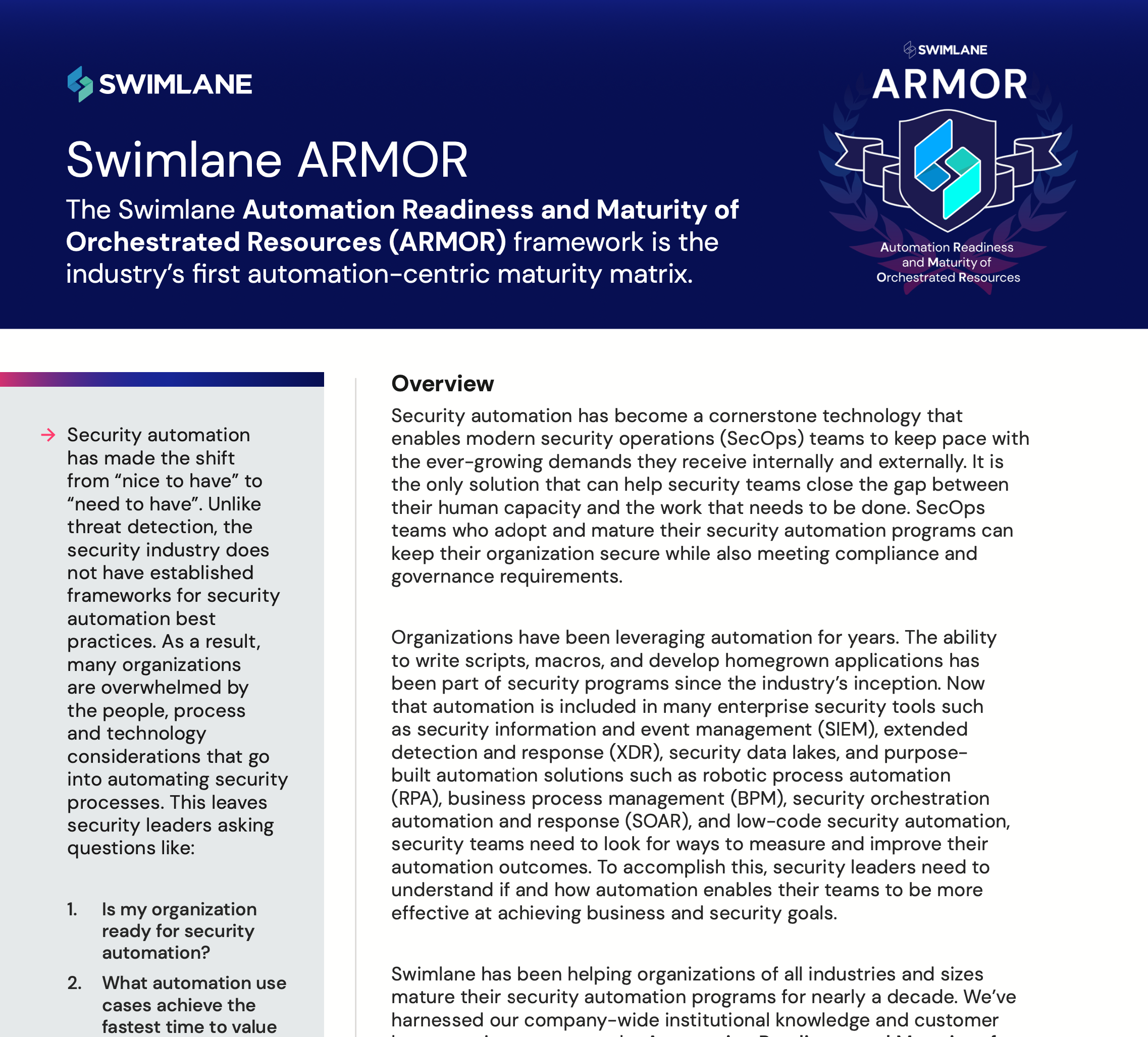With today’s unpredictable and evolving cybersecurity landscape, Swimlane understands that people alone can’t solve the critical challenges afflicting today’s security operations (SecOps) teams. Organizations demand a deep understanding of their automation readiness to enable security teams to navigate today’s cybersecurity warzone. Security automation is the only key to success. And with the effective fusion of human expertise and an AI-enabled low-code security automation platform, organizations can strengthen cybersecurity defenses. While the cybersecurity industry had numerous maturity frameworks, we noticed the absence of automation frameworks.
At Swimlane, we are committed to being a part of the solution – so we’d like to introduce you to the Automation Readiness and Maturity of Orchestrated Resources (ARMOR) Framework.
The ARMOR framework features a maturity matrix that empowers security professionals to establish their organization’s maturity baseline, evaluate SecOps capabilities on a five-level scale, and determine the next steps in the automation readiness process.
In prior posts, we analyzed the first three maturity levels that help make up the Swimlane ARMOR Framework:
In the foundational visibility stage, organizations may be challenged with establishing security strategies, filling headcount, and gaining leadership support. As they progress, those in the enriched visibility stage may grapple with effectively addressing security threats, a shortage of team expertise for advanced security tools, and fragmented SecOps visibility. However, at the automated response level, organizations demonstrate a high level of maturity in their security practices, utilizing automation where possible. Although, SecOps teams at this level still possess mid-level coding skills.
Now, it’s time to shift our focus towards the detailed exploration of ARMOR Level 4: Automated Prevention. Continue reading to understand what it means for an organization to operate at the automated prevention level within the Swimlane ARMOR Framework.
ARMOR Level 4 Unmasked: Automated Prevention
In the “automated prevention” phase, organizations have shifted from reactive to proactive automation. Organizations at this level have an automation first approach, well-defined processes and policies, and a security team with mature coding abilities. In this stage, security teams are doing the necessary work to make continuous progress towards the most secure security posture. While organizations in automated prevention have the foundational expertise in people, process, and technology, for automation success, security teams may still face challenges such as:
- Security automation beyond the SOC
- Building out use cases from scratch
- A company-wide mindset towards preventative and predictive processes
People in Automated Prevention:
Security teams at the automated prevention level have expanded their cybersecurity expertise by incorporating experienced industry team members into their headcount. A well-defined strategy is in place to ensure that skill development within teams aligns with the organization’s business objectives and desired outcomes. We commend team members at this level for their substantial experience in scripting capabilities and industry tenure. However, it’s crucial to empower security teams to address more complex use cases rather than solely enhancing their skills. This approach is vital for retaining top talent and swiftly advancing towards the next phase of automation readiness, advanced automated operations.
Process in Automated Prevention:
For organizations operating at this level, the evidence of their efforts is apparent in the well-established processes, policies, and procedures. Alongside this, security metrics are defined. Security teams at this phase focus on being as efficient as possible and are consistently exploring improvements to automate processes and provide real-time tracking and performance reporting. Given the clear verification and measurement processes, it’s crucial to prioritize results and establish a process to continuously optimize procedures based on KPIs. Doing this accelerates progress toward the next phase of automation readiness. This approach will help facilitate company-wide policies with preventive and predictive processes, while also utilizing automation across the entire organization.
Technology in Automated Prevention:
Now, let’s direct our attention to technology in the automated prevention phase. At this stage, organizations have implemented meticulously selected security tools that align and fit into their security tools portfolio and adopted industry-leading frameworks. This is a direct result of the comprehensive and thorough security posture that exists at the automated prevention level. The security tools achieve automated case and incident response, optimize tuning feedback and improve proactive threat detection. Teams in this stage of maturity also harness the capabilities of automation to translate common business processes and integrate them into existing security automation workflows, for example, approval processes, notifications, stakeholder interactions and response. Despite the extensive implementation of technology at this level, to achieve maximum efficiency, it’s essential to concentrate on fine-tuning tools, integrate AI/ML capabilities, alert correlation, prioritization, and automation logic.
To conclude, we want to extend an invitation for you to join us on this automation readiness journey, as we continue to dive deeper into the maturity levels that make up the Swimlane ARMOR Framework.

The Swimlane ARMOR Framework
SecOps teams who want to map their goals, tactics, and security automation use cases to industry standard frameworks like NIST, CMMC, CMMI or C2M2


